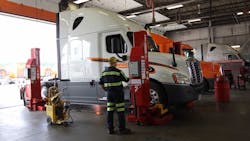Three ways to keep experienced diesel technicians on the job
The technician shortage is not expected to go away anytime soon, as demand continues to outpace supply. The U.S. Department of Labor’s Bureau of Labor Statistics projects the growth rate for diesel service technicians and mechanics will be 12 percent annually through 2024, almost double the average growth rate for all occupations. Industry reports show that the trucking industry alone will need 67,000 new technicians and 75,000 new diesel engine specialists by 2022.
As competition heats up for experienced heavy-duty technicians, and there are fewer replacements available, it’s crucial to keep senior truck technicians productive and on the job for as long as possible.
“It really benefits heavy-duty shops to avoid technician turnover and keep their more experienced techs working longer,” says Doug Spiller, heavy-duty product manager at Rotary Lift. “Experience counts, and there’s a long learning curve for new techs to really understand the complexities of modern heavy-duty vehicles. But experience gained can take its toll in a strenuous shop environment, and keeping techs in the 45-65 age range on the job without injury can be a challenge.”
Here are three ways to lessen the impact of their jobs on their bodies, to help keep them productive for years to come.
Provide a comfortable standing work position
Many shops have technicians working on their backs and on creepers in a somewhat dark environment. These conditions can expose technicians to knee issues, neck aches, back strains, hand pinches and knuckle busting as they work in awkward positions or are constantly transitioning from prone to standing. As people age, it also becomes more difficult to get up and down or even to slide under some of today’s trucks and buses that are designed to reduce wind resistance.
Vehicle lifts can address all of these issues by simply lifting the vehicle to an ergonomic position. This also provides more lighting under the vehicle and reduces the chances of materials dropping in technicians’ eyes. Invest in a lift to get your vehicles up in the air, so your techs can work in a more comfortable standing position.
When choosing a heavy-duty lift, also consider how it is operated. Some lifts require operators to crawl on their hands and knees to position adapters or to squat down to run the controls. All Rotary Lift heavy-duty lifts are operated standing up. Rotary is the only manufacturer to offer a versatile remote-controlled mobile column lift, as well as patent-pending pendant-only controls for its best-selling MOD35 heavy-duty inground lift.
Lighten the load
Using the right accessories can help technicians avoid back strain and other potential injuries. Mobile wheel lifts can remove and position any size wheel or tire weighing up to 500 pounds, making it much easier and more ergonomic for technicians to perform tire work on heavy-duty vehicles. Productivity jacks and transmission jacks take the load off of technicians to precisely remove and install various heavy vehicle assemblies such as transmissions, fuel tanks, DPF tanks and axles. Jobs that required two people can now be done by a single person supported by productivity tools.
Picking up and placing heavy steel frame-engaging adapters all day can be a lot like lifting weights at the gym. Rotary offers lightweight aluminum truck adapters with stackable inserts to lessen this strenuous daily technician exercise.
For two-post lifts, Rotary Lift offers the Wheel Wing, a convenient holding spot for tires affixed to the lift arms. Techs simply slide the tire onto the attached rod instead of lowering it to the floor, and back up again.
Make it easier to see
Age can bring changes that affect the eyesight. Many people experience decreases in vision over the age of 40. In a heavy-duty shop, this is exacerbated when a vehicle partially blocks overhead lights.
Vehicle lifts get heavy-duty vehicles up in the air, which in itself usually improves undercarriage visibility. But to really shine a light on even hard-to-reach problem areas, consider investing in supplemental lighting. The Rotary Lift Tech Light series offers several options of LED lights that can be adapted to meet a variety of service bay needs. These slim one-inch diameter versatile lights are available as a hand-held wand, or in multi-light solutions for mobile column, two-post and runway-stye lifts. They are supplied with magnetic clips for precise positioning (no drilling necessary).
